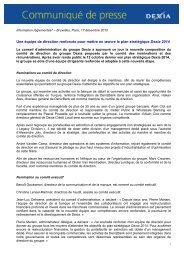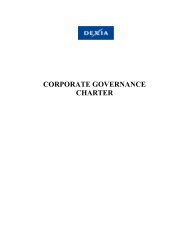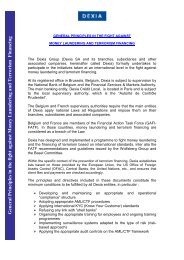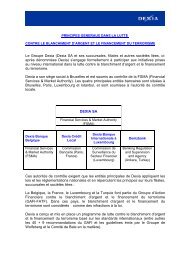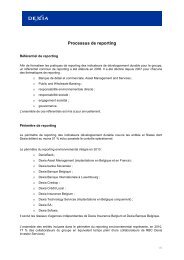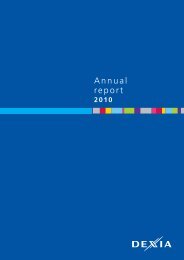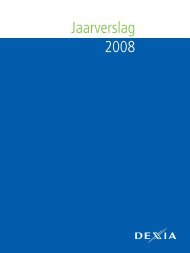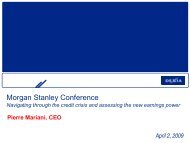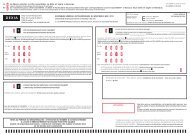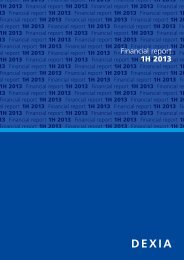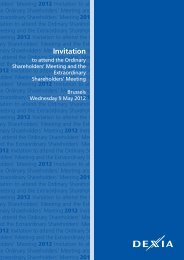Risk managementManagement <strong>report</strong>Consolidatedfinancial statements<strong>Annual</strong> financial statementsAdditional informationThe Basel II frameworkSince 1 January 2008 the <strong>Dexia</strong> Group has used the AdvancedInternal Rating Based Approach (AIRBA) for calculating itscapital requirements and its solvency ratios. New models havebeen developed and will progressively be used for calculatingregulatory capital as from 31 December 2010.The year <strong>2009</strong> was marked by progress in the implementationof Pillar 2. This mechanism, applicable since 31 December2008, requires banks to demonstrate to their regulatorsthe appropriateness of their risk profile and their capital.To do so, they must in particular have internal systems forthe calculation and management of their risks, capable ofmaking a valid assessment of their economic capital needs(Internal Capital Adequacy Assessment Process − ICAAP). Thisprocess is thus based on two main processes: risk analysisby the Risk Management and the financial plan (includinga capital allocation and an analysis of the evolution of theresults of business lines as well as the internal capital supply)by the Finance department. As Pillar 2 of Basel II is a totallyintegrated and transversal process, the Pillar 2 file essentiallyconsists of the file established at <strong>Dexia</strong> SA level, of whichsome parts have been set at entity level.The first quantitative ICAAP <strong>report</strong> was submitted on15 March <strong>2009</strong> and a first presentation on <strong>Dexia</strong>’s Pillar 2approach was made on 25 March <strong>2009</strong> to its 12 principalregulators. The <strong>com</strong>plete file was submitted on 30 June <strong>2009</strong>on the basis of the Group’s strategic reorientation. In-depthPillar 2 inspections were performed by the college of regulatorsin the fourth quarter of <strong>2009</strong>.The Board of Directors and the Management Board of<strong>Dexia</strong> SA have been kept fully informed of developmentswith regard to Pillar 2.Pillar 3, which defines a range of qualitative and quantitativeinformation in relation to risks distributed to marketoperators, is applicable at the highest consolidated level ofthe <strong>Dexia</strong> Group and has been part of the external <strong>com</strong>municationof <strong>Dexia</strong> SA since 2008 (see the document RiskReport – Pillar 3 of Basel II published on <strong>Dexia</strong>’s websitewww.dexia.<strong>com</strong>).Finally, <strong>Dexia</strong> is closely involved in national and internationalconsultations on the subject of amendments to the CapitalRequirement Directive and, more generally, in the ongoingdiscussion on the optimum level of capitalisation for banks(dynamic funding, leverage ratio, definition of capital and soon).Credit riskDefinitionCredit risk represents the potential loss (decrease of assetvalue or payment default) which <strong>Dexia</strong> may incur as a resultof deterioration in the solvency of any counterparty.Governance<strong>Dexia</strong> Risk Management oversees its credit risks under thesupervision of the Management Board and specialist risk<strong>com</strong>mittees. It is responsible for elaborating credit-risk policiesand guidelines, including the decision-taking process andthe framework for delegations, and supervising the rating/analysis processes as well as the exposure surveillance functions.In order to optimise the appropriateness of the skillsin the Risk department and their field of intervention, RiskManagement will evolve over 2010 into an organisationwith specialist expertise centres consistent with the various<strong>Dexia</strong> business lines (Retail and Commercial Banking CreditRisk, Public and Wholesale Banking Credit Risk, and MarketOperations Credit Risk) giving rise to the establishment ofrisk <strong>com</strong>mittees specialising per expertise centre, the overallcoordination of which will be in the hands of transversal<strong>com</strong>mittees.Transversal <strong>com</strong>mitteesThe Risk Policy Committee, organised quarterly, approves thecredit assignment rules, which are detailed in the credit-riskpolicies.The Risk Executive Committee, organised weekly, decides onthe risk management strategy and the organisation of thesupport line.The Management Credit Committee, organised weekly,takes binding decisions on major files or credit files with anincreased credit risk.Credit-risk management falls within the more general frameworkof the internal capital adequacy process (cf. internalcapital adequacy in this chapter).Committees specialising per expertise centreThe decision-making process applied to transactions isorganised via a series of credit <strong>com</strong>mittees. These areorganised per specialist expertise centre, and approve transactionswhich are not delegated to the entities. All of these<strong>com</strong>mittees operate under the delegation of the ManagementCredit Committee. A transaction is delegated on thebasis of specific delegation rules, depending upon the type ofcounterparty, rating levels and credit-risk exposure. Sub<strong>com</strong>mitteeshave been created within the Group (entities, subsidiariesand branches) to deal with credit delegations. Eachfile presented to a credit <strong>com</strong>mittee contains an independentanalysis made by the Risk Management department.The Special Mention and Watchlist Committees of the expertisecentres and of the entities monitor “sensitive” assetsplaced on watch. The <strong>com</strong>mittees are organised quarterly.The Default Committees of the expertise centres and of theentities define and monitor counterparties in default accordingto Basel II applying the rules which prevail at <strong>Dexia</strong>. These<strong>com</strong>mittees are organised quarterly.The Impairments Committees of the expertise centres andof the entities draw up quarterly <strong>report</strong>s on the amount ofprovisions allocated and monitor the cost of risk. These <strong>com</strong>mitteesare organised quarterly.56<strong>Dexia</strong> <strong>Annual</strong> <strong>report</strong> <strong>2009</strong>
Risk managementThe Rating Committees of the expertise centres and of theentities deal with the correct application of internal ratingsystems as well as the adequacy of the rating processes.These <strong>com</strong>mittees are organised quarterly.The Credit Line Committee attributes and checks the limits forcertain counterparties monitored by the expertise centre for creditrisk on market operations. This <strong>com</strong>mittee is organised quarterly.Management of the risk<strong>Dexia</strong> manages its credit risk by assessing it, controlling it andtaking the measures necessary to limit it.Credit-risk limits are defined in order to manage the generalrisk profile and to limit concentrations of risks. A limit is fixedfor a given counterparty, in line with credit-risk policy. Such limitrepresents the maximum exposure to the credit risk that <strong>Dexia</strong>is willing to accept for that given counterparty. Limits may alsobe imposed per economic sector and per product. In order totake more recent events into consideration, specific limits maybe frozen at any time by the Risk Management department.As to risk management of derivatives, <strong>Dexia</strong> closely monitorsthe conclusion of appropriate legal documentation relating tonetting agreements and the exchange of collateral. During theyear <strong>2009</strong>, important efforts have been made as to the streamliningof the valuation process of derivatives in the perspectiveof an appropriate collateral management and subsequentlyreducing credit risk. Credit Default Swaps are used in the contextof intermediation and mitigation of risk concentrations.In order to assess its credit risk, <strong>Dexia</strong> relies in particular ona series of internal rating systems put in place under Basel II.Credit-risk analysts are responsible for assigning a rating toall counterparties. Each rating corresponds to an assessmentof the counterparty’s risk level expressed in accordance withan internal scale which, without duly substantiated exception,takes into account the possible risk associated with the countryin which it is established. On attribution, the internal ratingconstitutes a key element in the decision taken by the credit<strong>com</strong>mittee. An annual ratings review enables counterpartiesto be proactively identified and this requires regular monitoringwhich will then be entered in a quarterly watchlist, jointlyreviewed by the Credit Risk department and the Sales department,within a Special Mention & Watchlist Committee.The global credit-risk environment in <strong>2009</strong><strong>2009</strong> will have been the year for economic recovery policiesthrough government and central bank intervention. Theeconomic context was unfavourable however, marked by anincrease of unemployment and a loss of confidence amongconsumers and entrepreneurs. The year will also in many wayshave been one of paradox. Indeed, although the amount ofcorporate debt at a global level was down for the first time inat least fifteen years, bond investors returned in large numbersto the capital market and a record volume of non-financialbonds was placed in Europe. Against a background of lowrates, at the beginning of the year this segment offered substantialpremiums which then tightened considerably.The main domestic credit markets evolved similarly, with a riseof household finance and a decline of corporate finance. Thelatter also diversified their sources of financing by calling moreon the market, particularly as the banking sector, confrontedby higher capital requirements, remained constrained in its abilityto provide loans. In part this explains the global downturnof this market, which was followed over the entire course ofthe year by clearly unseasonable negative flows. On the otherhand, the mortgage market rose, in view of the low interestrates and public incentives to green investment.Fundamentals of <strong>Dexia</strong> credit risk in <strong>2009</strong>The deterioration of the macroeconomic environment is perceptiblein <strong>2009</strong> in the <strong>Dexia</strong> portfolio. The average rating ofthe portfolio declined over the year, particularly in the firstquarter, and collective impairments were made in order toface the possible consequences of that deterioration. The<strong>Dexia</strong> asset base held up well and confirmed the low riskprofile of the Group’s business lines. The <strong>Dexia</strong> portfolio wassignificantly reduced with the sale of FSA Insurance, finalisedon 1 July <strong>2009</strong>.In its credit-risk management, in <strong>2009</strong> <strong>Dexia</strong> continued tointegrate the weakening of the economic system (increasein observed default rates, unfavourable macroeconomic situationand so on) related to the current financial crisis, andcontinued to strengthen the process for identification andmonitoring of sensitive files and sectors. Furthermore, thelimits which necessitated this were revised downwards and inparticular on bank, corporate, country and sovereign counterparties;some activities were suspended and deleveragingoperations continued (cf. infra).Retail and Commercial Banking saw a moderate increase in thecost of risk in Belgium and Luxembourg, but the deteriorationwas more severe in Turkey, where the crisis affected the <strong>com</strong>mercialportfolio and resulted in unfavourable ratings migrations.In Public and Wholesale Banking, fundamentals remain globallyextremely sound. In the field of corporate credit, closemonitoring was introduced (review of delegations, loweringof limits) on the most weakened project finance sectors(shipping, port activities and motorway infrastructure), with amajor proportion of the debt being restructured.The year <strong>2009</strong> was marked by a major reduction of thebond and structured products portfolio, where productionwas ceased and the portfolio deleveraging programmecontinued. Although no incident or clear deterioration wasnoted in terms of performance or expected loss, the impactof the crisis was felt and resulted in rating downgrades.The deterioration was obvious above all in the segments ofCLO (risks to a large extent mitigated) and RMBS in Spain,the United Kingdom and the United States. The bond portfolioremained at 97% investment grade and the FinancialProducts port folio, at a longer maturity, saw its quality(43% investment grade) and its level of specific impairmentsstabilise.Sovereign risk was reduced on countries presenting a highrisk or those considered more vulnerable. The risk on bankingcounterparties evolved in various ways but no default wasobserved within the portfolio. The indirect risk on monolinerswas also reduced following the cessation of liquidity lineactivity in New York and the disposal of certain assets.Management <strong>report</strong>Consolidatedfinancial statements<strong>Annual</strong> financial statementsAdditional information<strong>Annual</strong> <strong>report</strong> <strong>2009</strong> <strong>Dexia</strong> 57



